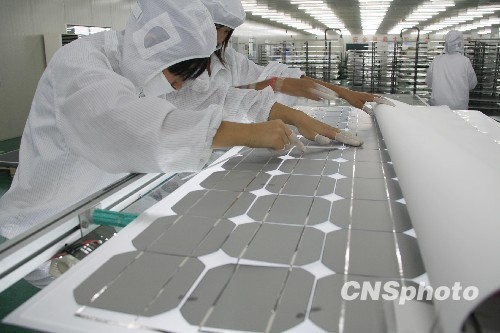
(Ecns.cn) -- Stocks of Chinese photovoltaic (PV) manufacturers have fallen for four consecutive quarters since last September, caused by weakening demand, a lack of government aid, fiercer anti-dumping actions and cuts to solar energy subsidies abroad, reports China Economic Weekly.
To address the situation, PV companies are developing the market by widening their coverage of services abroad while hoping the government takes steps to boost domestic demand.
Last Monday, solar products-maker LDK Solar Co., Ltd. announced it had signed three multi-year contracts to construct 600 megawatts worth of solar PV plants in northwest China's Gansu Province.
The contracts demonstrate continued demand for solar development in China, yet the announcement comes at a time when LDK's stock has declined sharply and analysts have expressed concern about the company's enormous debt. There has even been speculation of bankruptcy.
To make matters worse, actions by governments abroad have threatened to dampen exports.
Late last month, 17 PV companies announced the establishment of the Solar Energy Promotion Alliance in Shanghai in response to a preliminary ruling by the U.S. to levy exorbitant anti-dumping tariffs on Chinese PV exporters.
Sustained losses
Chinese-owned Suntech Power Holdings Co., the world's largest producer of solar panels, posted a quarterly loss for the first three months of this year, during which it lost $133 million, or 74 cents per U.S.-traded share.
According to China Economic Weekly, the company's Q1 revenue slid 53 percent to $409.5 million from $877 million a year ago, down 34.9 percent compared to last year's Q4 revenue.
Dr. Shi Zhengrong, Suntech's founder and chief executive officer, says the declining trend of solar companies' margins will last for up to one year, and may last longer if the oversupply of solar panels continues to drive down prices.
China produces the world's largest number of solar panels, and more than 90 percent of its solar products are exported, so adjustments to policies in other countries can easily affect the sector, an industry watcher tells China Economic Weekly.
In recent months, punitive tariffs by the U.S. Department of Commerce on imported Chinese solar cells have hit the sector hard.
Moreover, a growing number of reports suggest that an anti-dumping case could be brought against Chinese PV manufacturers by the EU within the next month. If those reports are true, other countries such as India may follow suit, which could be devastating, says the same industry watcher.
To boost demand
In May, China's Ministry of Finance, Ministry of Science and Technology and the National Energy Administration announced that the "Golden Sun" program would increase subsidies to boost solar power deployment to 1,709 megawatts, or 2.85 times that of last year.
Golden Sun was first launched in 2009 to subsidize demonstrative PV projects in the country, but most PV companies say the program has done little to ensure large market demand.
Under such circumstances, PV manufacturers have been forced to expand into overseas markets, and a Japan troubled by nuclear disaster has become a good choice.
On May 5, Japan's last nuclear unit in Hokkaido ceased operation, ushering the country into a nuclear-free era. Yet before the Fukushima crisis, Japan had planned to increase its nuclear-generated electricity to 45.4 percent of its total power production.
Chinese solar power companies have smelled an opportunity, made all the more attractive by Japan's high subsidies for electricity prices.
Although it is more difficult for PV manufacturers to enter Japan's market due to strict standards for qualified solar companies (which must obtain a JPEC certificate from the Japan Photovoltaic Energy Association or a JET certificate from Japan Electrical Safety & Environment Technology Laboratories), Chinese enterprises remain optimistic about the opportunities there.
Only about five Chinese PV companies will get their JET certificates this year, but it is worth the wait, says a sales manager at CEEG Solar Panels.
Better strategy needed
When the Solar Energy Promotion Alliance was established, Chinese solar panel makers quickly voiced their opposition to the U.S. ruling, saying the move will harm manufacturers in both countries.
Faced with continuous international pressure, they believe they should strengthen cooperation in a harsh trading environment.
But apart from their efforts, China's current mode of electric power generation is the source of much debate, and many argue that further reforms are necessary to boost domestic demand.
According to China Economic Weekly, the State Grid and China Southern Power Grid have taken nearly total control of the country's electricity transmission and distribution market, leaving none to the PV companies.
Zhang Shiping, Shandong Province's richest man and controller of a conglomerate that spans textiles and aluminum, has set up his own company (Weiqiao Group) to produce electricity for his enterprises. Zhang's employees can use electricity from Weiqiao Group at a price of 0.35 yuan per kWh, much lower than the State Grid's price of over 0.6 yuan per kWh.
This is a good example of action that can change the current electricity transmission and distribution market, but such moves need more support from the government, says the CEO of a PV company.

Copyright ©1999-2011 Chinanews.com. All rights reserved.
Reproduction in whole or in part without permission is prohibited.